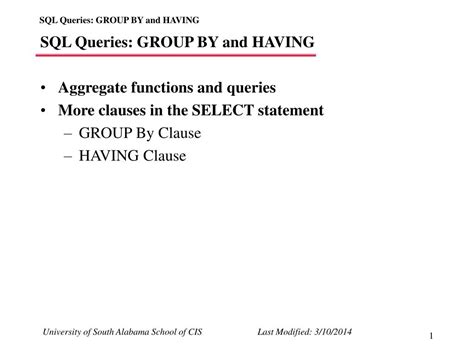When working with databases, the GROUP BY clause is a powerful tool used to group rows that have the same values in one or more columns. Typically, it is used in conjunction with aggregate functions like SUM, AVG, MAX, MIN, and COUNT to perform calculations on each group. However, there are scenarios where you might want to use GROUP BY without an aggregate function, which can seem counterintuitive at first but serves specific purposes in data analysis and retrieval.
Understanding GROUP BY and Aggregate Functions

To grasp the concept of using GROUP BY without an aggregate function, it’s essential to understand how these components work together. An aggregate function calculates a value from a set of values. Each row in your result set is a summary of the rows in your table that match a specific condition, defined by the GROUP BY clause. For example, if you want to find the total sales amount by region, you would use a query like this:
SELECT region, SUM(sales_amount) AS total_sales
FROM sales_table
GROUP BY region;
This query groups all sales by region and then applies the SUM aggregate function to calculate the total sales for each region. However, there are instances where you might not need an aggregate function but still want to group your data.
Scenarios for Using GROUP BY Without Aggregate Functions
There are specific scenarios where using GROUP BY without an aggregate function makes sense, such as when you want to retrieve all unique combinations of certain columns. Although this can be achieved with the DISTINCT keyword, there are cases where GROUP BY is more appropriate or convenient.
For example, suppose you have a table of student enrollments in different courses and you want to list all unique course and semester combinations. You could use a query like this:
SELECT course_id, semester
FROM enrollments
GROUP BY course_id, semester;
This query will return each unique combination of course_id and semester, without the need for an aggregate function. It's essentially finding distinct combinations, similar to using SELECT DISTINCT, but through grouping.
Another Scenario: Using GROUP BY with HAVING
Another common scenario where GROUP BY is used without an aggregate function in the SELECT clause is when you use the HAVING clause. The HAVING clause allows you to filter grouped results based on conditions applied to the groups. Even though you’re not using an aggregate function in the SELECT statement, you’re still applying aggregate conditions to filter the results.
For example, if you want to find all departments that have more than 10 employees, you could use a query like this:
SELECT department_name
FROM employees
GROUP BY department_name
HAVING COUNT(employee_id) > 10;
In this example, the COUNT aggregate function is used in the HAVING clause to filter the departments, but not in the SELECT clause.
Real-World Applications
In real-world applications, the use of GROUP BY without aggregate functions can be seen in data analysis tasks where the goal is to understand the distribution or presence of certain data combinations. For instance, in e-commerce, you might want to identify all unique product categories and subcategories without calculating any aggregates, to plan your marketing strategy or optimize your product offerings.
| Category | Subcategory |
|---|---|
| Electronics | Smartphones |
| Electronics | Laptops |
| Fashion | Clothing |
| Fashion | Accessories |

This kind of analysis helps in understanding the breadth of your product offerings and identifying gaps or areas for expansion.
Key Points
- GROUP BY can be used without aggregate functions to find unique combinations of columns.
- The HAVING clause allows filtering grouped results based on aggregate conditions, even if no aggregate functions are in the SELECT clause.
- Real-world applications include data analysis for understanding data distributions or planning strategies.
- Using GROUP BY without aggregate functions is about identifying unique groups or setting up data for further analysis.
- It's essential to understand the purpose and benefits of using GROUP BY in various scenarios to leverage its full potential in data retrieval and analysis.
Best Practices and Considerations

When deciding to use GROUP BY without an aggregate function, consider the following best practices and considerations:
- Data Integrity: Ensure your data is clean and accurate to avoid incorrect groupings.
- Performance: Be mindful of the size of your dataset and the impact of grouping on query performance.
- Query Clarity: Use clear and descriptive column names and comments to explain the purpose of your query.
- Alternative Approaches: Consider whether using DISTINCT or other SQL features might better achieve your goals.
By following these guidelines and understanding the scenarios where GROUP BY without aggregate functions is beneficial, you can enhance your SQL skills and effectively manage and analyze your data.
What is the primary purpose of using GROUP BY without an aggregate function?
+The primary purpose is often to identify unique combinations of columns or to prepare data for further analysis or filtering.
How does the HAVING clause relate to using GROUP BY without aggregate functions in the SELECT clause?
+The HAVING clause can still be used with aggregate functions to filter the grouped results, even if no aggregate functions are used in the SELECT clause.
What are some real-world applications of using GROUP BY without aggregate functions?
+Real-world applications include data analysis for understanding product distributions, planning marketing strategies, and optimizing product offerings based on unique category and subcategory combinations.



